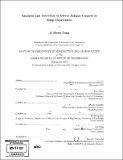| dc.contributor.advisor | Eric Feron and Joseph Coughlin. | en_US |
| dc.contributor.author | Yang, Ji Hyun, 1978- | en_US |
| dc.contributor.other | Massachusetts Institute of Technology. Dept. of Aeronautics and Astronautics. | en_US |
| dc.date.accessioned | 2008-09-03T14:49:02Z | |
| dc.date.available | 2008-09-03T14:49:02Z | |
| dc.date.copyright | 2007 | en_US |
| dc.date.issued | 2007 | en_US |
| dc.identifier.uri | http://hdl.handle.net/1721.1/42178 | |
| dc.description | Thesis (Ph. D.)--Massachusetts Institute of Technology, Dept. of Aeronautics and Astronautics, 2007. | en_US |
| dc.description | Includes bibliographical references (leaves 167-181). | en_US |
| dc.description.abstract | Human errors in attention and vigilance are among the most common causes of transportation accidents. Thus, effective countermeasures are crucial for enhancing road safety. By pursuing a practical and reliable design of an Active Safety system which aims to predict and avoid road accidents, we identify the characteristics of drowsy driving and devise a systematic way to infer the state of driver alertness based on driver-vehicle data. Although sleep and fatigue are major causes of impaired driving, neither effective regulations nor acceptable countermeasures are available yet. The first part of this thesis analyzes driver-vehicle systems with discrete sleep-deprivation levels, and reveals differences in the performance characteristics of drivers. Inspired by the human sleep-wake cycle mechanism and attributes of driver-vehicle systems, we design and perform human-in-the-loop experiments in a test bed built with STISIM Drive, an interactive fixed-based driving simulator. In the simulated driving, participants were given various driving tasks and secondary tasks for both non and partially sleep-deprived conditions. This experiment demonstrates that sleep deprivation has a greater effect on rule-based tasks than on skill-based tasks; when drivers are sleep-deprived, their performance of responding to unexpected disturbances degrades while they are robust enough to continue such routine driving tasks as straight lane tracking, following a lead vehicle, lane changes, etc. In the second part of the thesis we present both qualitative and quantitative guidelines for designing drowsy driver detection systems in a probabilistic framework based on the Bayesian network paradigm and experimental data. | en_US |
| dc.description.abstract | (cont.) We consider two major causes of sleep, i.e., sleep debt and circadian rhythm, in the framework with various driver-vehicle parameters, and also address temporal aspects of drowsiness and individual differences of subjects. The thesis concludes that detection of drowsy driving based on driver-vehicle data is a feasible but difficult problem which has diverse issues to be addressed; the ultimate challenge lies in the human operator. | en_US |
| dc.description.statementofresponsibility | by Ji Hyun Yang. | en_US |
| dc.format.extent | 181 leaves | en_US |
| dc.language.iso | eng | en_US |
| dc.publisher | Massachusetts Institute of Technology | en_US |
| dc.rights | M.I.T. theses are protected by
copyright. They may be viewed from this source for any purpose, but
reproduction or distribution in any format is prohibited without written
permission. See provided URL for inquiries about permission. | en_US |
| dc.rights.uri | http://dspace.mit.edu/handle/1721.1/7582 | en_US |
| dc.subject | Aeronautics and Astronautics. | en_US |
| dc.title | Analysis and detection of driver fatigue caused by sleep deprivation | en_US |
| dc.type | Thesis | en_US |
| dc.description.degree | Ph.D. | en_US |
| dc.contributor.department | Massachusetts Institute of Technology. Department of Aeronautics and Astronautics | |
| dc.identifier.oclc | 228869677 | en_US |
